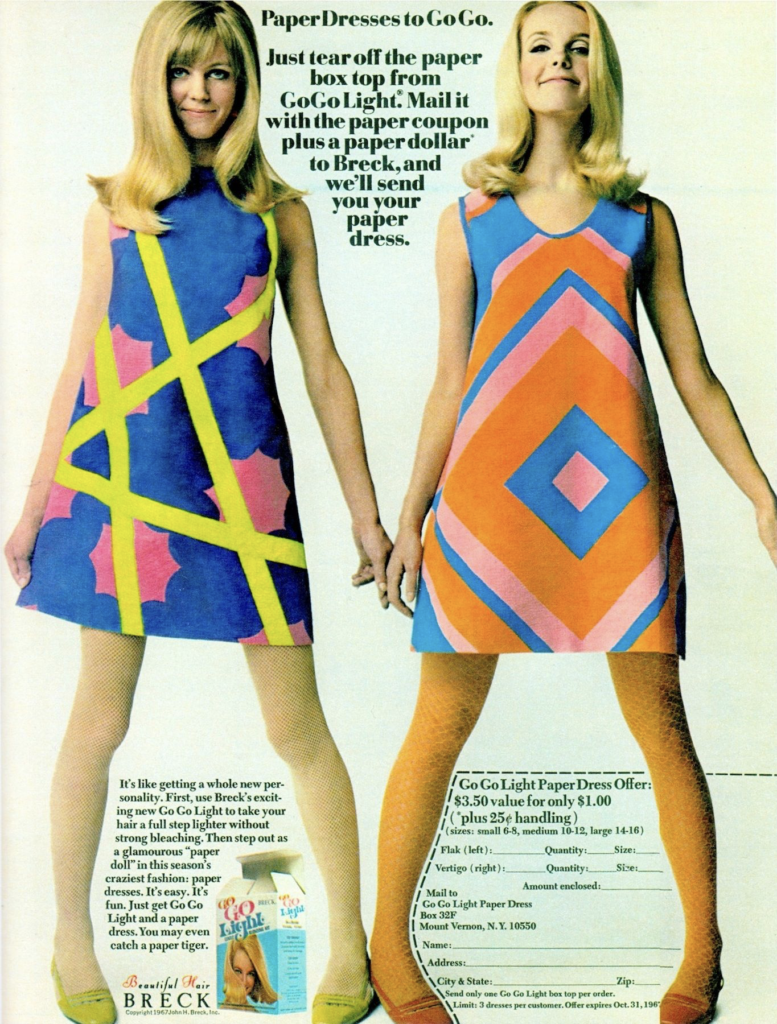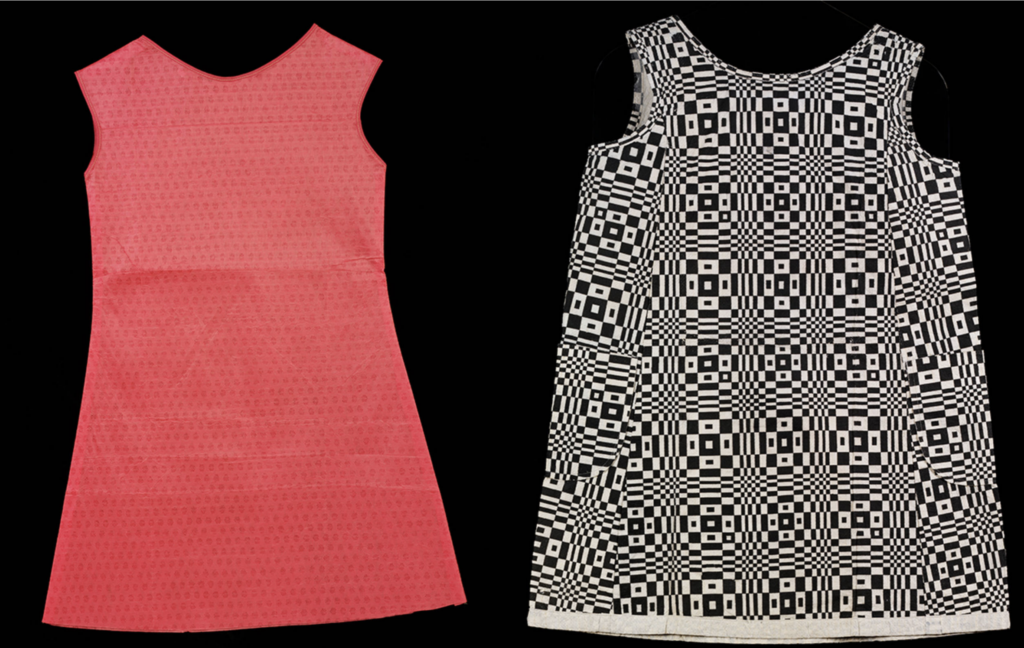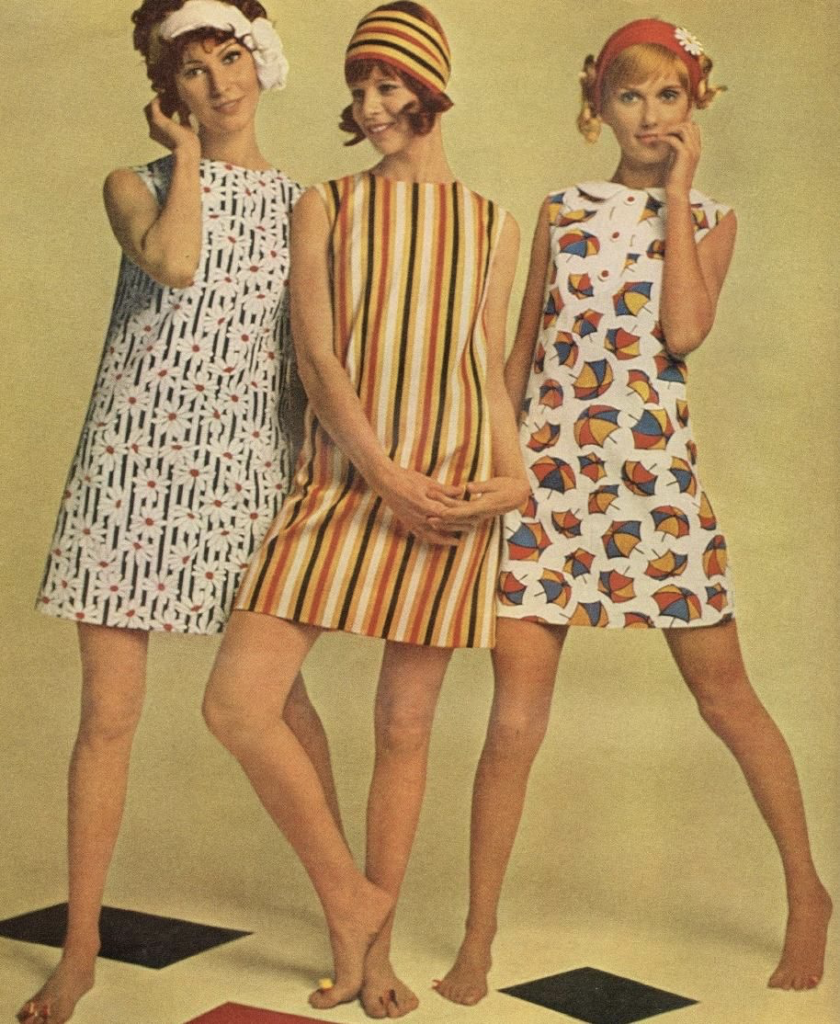Paper Fashion of the Past – Annabel M
Disposable paper dresses were the peak of popularity in 1966-68. During this time society became incredibly wasteful, with a ‘throw-away’ mindset. Young people fell in love and embraced the new cult that was different fun and fast changed with new trends. The dresses were cheap and disposable. The dresses featured blood graphic prints, which became popular during the sixties. Designed to only been worn once or twice young people couldn’t get enough of them. This essay with be looking at where the paper dress originated from, and the path it took in its short life. It will then look at Diane Meyersohn and Joanne Dispo Silverstein’s (Meyersohn & Silverstein Ltd) work and how their dresses were different from the rest. I will then discuss how it would fit in within todays society and final what I would do if I had to develop it into my own work.

The paper dress was made during 1967 by a designer called Diane Meyersohn (designer) Silverstein, Joanne Dispo (Meyersohn & Silverstein Ltd) (designer). However, they were not the designers that invented the paper dress. That job was done by Scott Paper Company (Victoria and Albert Museum, London, 2018). The dress was not designed to be a fashion item, but simply for marketing and a publicity tool. The customer would be able to buy the dress for one dollar and receive a coupon for a Scott Paper product.
Scott Paper created two designs of the paper dress. They described the dress as a conversation starter at parties, smashingly different at dances or perfectly packaged at picnics. You were able to wear them anytime or anywhere. Scott paper became overwhelmed with the promotion and had to put and end to it after only six months. It was said the stopped the manufacturing of the paper dress because they didn’t want to be known for their dress production.
This gap in the market was soon filled by mars manufacturing company of Asheville(Curators of the University of Missouri, 2020). They soon became the leading producer of the paper dress, making up to 100,000 dresses a week. Which meant the sales of dresses became more varied, from an A-line dress to a bell bottom jump suit. Even making Childs clothes and also swimming costumes. After WW2, which brought the ’make do and mend’ attitude women were over joyed with the no sew dresses and reject the ‘make do and mend’ attitude . Being able to be altered in minutes with some scissors and sellotape. This left women with a lot of spare time and they were able to explore the increasing freedom that was being presented during the decade. (Victoria and Albert Museum, London, 2021)

The dress was ideal if you need something quick and easy to grab hold of. When travelling they were perfect as you’re able to pack lighter meaning you would have more space for stuff collected on holiday. It also meant you didn’t need to bring them back with you as you could leave them in the bin on holiday.
The desire for the dresses to be worn more than once grew, this was unsurprisingly as the original dress would rip and teared very easily. The advance in material technology mean they were able to be developed, a stronger and more robust material, the material was made out of wood pulp and synthetic fibres like rayon, nylon and polyester. This material created was able to be ironed on a low setting to ‘refresh’ the dress. They were even able to be washed, however not more than once or twice. This new fad looked like It could have been a long turn alternative not traditional fabric, that was until high street shops were able to make and produce cheap, long lasting fabrics that became more desirable to the consumer. By the end of the decade, women began to fall out of love with the paper dress as the hippy culture rejected the ‘throwaway’ mindset. By the end of 1968 the paper dress became a thing of the past. However, all way not lost and the dress did still live on but not in the first intended area. The material is now used in hospital as gowns and scrubs. This is because they need a cheap and disabled material for when the are working on/ having operations.

This dress was made in London in 1967. It was designed by Diane Meyersohn, Joanne Dispo Silverstien (Meyersohn & Silverstein Ltd). During the late sixties the two designers learnt of the paper dress tend from the USA and wanted to develop their own dresses. They wanted to create a bold and graphic 2D dress. They used a new fibre out of bonded cellulose. This fibre was made from naturally occurring cellulose materials. The materials are chemically devolved and then regenerated into a new fibre. Rayon, lyocell and acetate are the most commonly used. Wood pulp is the most common source to make this fiber out of but cotton, remie, flax, jute and bamboo are also used too. These dresses they created were found to be able to be worn hat least six times, Which magazine discovered this in a consumer trial. This was while other brands were only able to withstand two or three times of being worn.

Visually this dress is very eye catching and was desirable to wear durning the sixties. Having the ability for them to be massed produced meant the patterns and prints would be changed regularly, keeping up with the latest trends and fashion. This simple cut of and A-line dress, which became trendy during the sixties makes it stand out from other dresses which were perviously fashionable in the decade before. A-line dresses are very simple and unflattering, having no shape around the waistline. The dresses didn’t fit tightly around the bust, it sat on the shoulders and went straight down from the armpits. The cut was iconic for the sixties and the paper dress took the simple design and developed something new, different and modern for the time. The bright and graphic colours that are seen on the paper dresses were taken from the new liberal styles that were being seen in the sixties, which hadn’t really been featured before in the fashion industry. (V is for Vintage, 2021)

I think the dress was ahead of it time, as I feel it had every really been seen before due to the ‘make-do and mend’ attitude, as people were reusing thee old clothes and turning them into something new. During the sixties there was rapid growth within the UK economy and there was minimal unemployment, which mean that the people were earning money for themselves to have more of a disposable income. They are now able to spend their hard earned money on things that they want and treat themselves to different things.

Other paper dress designed at the time featured bold and bright patterns too. But this was the style of the time. As a-line dresses with bold bright patterns were the statement style during the sixties. Fashion became progressive. It was fun, youthful and popularised by swinging London. The swinging sixties saw a flourish in art and music, which was then reflected in the fashion. Twiggy and Jean Shrimpton were the key ambassadors of the sixties fashion. They featured in the most iconic fashion statements of the time. (Wikipedia, 15 January 2021)
In todays fashion industry I think this would be best marketed at the festival/ rave industry, as these sort of events would best suit this style of dress. It would suit this sort of industry as they can get very messy and you’re like to get dirty so having clothing that would only be intended to worn once or twice it would be great, as if it is damaged it isn’t the end of the world. Also when going to a festival or rave the clothing worn isn’t alway clothing that would be worn day to day. So buying clothes specifically for a festival would just be disposed of would be ideal. Having such bright colours would also appeal to this industry as is it something that is desired.
However, there is another side to this argument, the paper dress can be seen as wasteful and not good for the environment. Even thought the material is mostly made out of paper it does have some synthetic materials in it, which will not biodegrade, so the dress will, in some form be on the plant for forever. Also having bright colours tends to mean there is harsh chemicals that are being used too, which offend end in in rivers and water ways, which become toxic for humans and animals that come it to contact with them.

The paper dress formula is still used in today society, it is used for hospital gowns and scrubs. They use disposable clothing as it is cheaper and easier to throw it away rather than having to wash it and sterilise it. The paper dresses are able to a produced and sterilise relatively easily for doctors and patients to use to where they need them.
If I had to develop this into work of my own I think it would be very interesting as it is not a material that oi would normally work with and isn’t familiar to me. There would be different problems and challenges like easily ripping and tearing that I wouldn’t experience with other fabrics like calico. Also experimenting with the bold patterns and prints would be exciting as it’s not always something that I would be able to do. Working with the paper material wouldn’t necessarily need to be sewn so I would be using sellotape and glue rather than a machine or needle and thread. This is because the paper may rip and tare.

To conclude paper dress was a whirlwind fashion statement. The trend was only around for a short time but never the less it has a large impact on the fashion world. The dress was new and innovate. Originally created as part of an invented and resourceful marketing campaign to promote this new and modern paper technology. Diane Meyersohn and Joanne Dispo Silverstein’s (Meyersohn & Silverstein Ltd) then took this new fad and developed their own version of the paper dress. They created something that able to be worn for more than one time, even thought their version was only able to be worn five or six time it was still a step up from Scott paper’s take on the paper dress. They developed bold and bright patterns to feature on the paper, which these patterns were on trend for in the sixties. Although the paper dress didn’t stick around as a permanent trend like it was originally believed too, it has stay in another area of clothing. The paper dress live on with in a hospital environment. So the creation has not died out completely. The want for a dress to last longer than one or two years grew, so the paper dress fad slowly faded out and became a short lived trend, even though the paper clothing was very popular and trendy. It wasn’t to last for forever like some thought.















Post Comment
You must be logged in to post a comment.